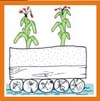From TKWB - Traditional Knowledge World Bank
Jump to navigation
Jump to search
| LOCAL APPLICATION OF THE TECHNIQUE |
 |
| Technique: |
FLOATING GARDENS |
| Local name: |
Chinampas |
| Site: |
Xochimilco, MEXICO |
|
Location

Click the globe to see the techinique on Google Map
|
Continent: North America
Country: Mexico
Site: Xochimilco
Coordinates:
Lat:
19.25
Long:
-99.10 |
Description of the local variant of the technique
The chinampa, the Aztec floating gardens, with plants which directly absorb the necessary water through their roots are an example of the creation of a space that can be cultivated when there is water in excess. Large wooden rafts are anchored on lakes and marshes. A layer of soil with earth and manure is spread on top. Humidity passes directly from the wood to the roots of the plants, which thus obtain the water they need without irrigation. Among the pre-Columbian techniques the chinampa were disseminated by the Toltec population after the fall of Tula in 1165 AD. The water of the marshlands irrigates the soil where the plants grow, directly from below, supported by wooden bases that in some cases may actually float. Nowadays, at Xochimilco, a town 30 kilometres from Mexico City and whose name means 'place of the fields of flowers', the chinampa are arranged in chequered cultivations. Like islands in the freshwater lagoon, they are separated by a regular layout of canals, which can be navigated by flat bottomed boats. The present situation is closer to the feixe than to gardens on floating rafts.
Survival prospects
Still in use.
Images


Deepening
|
TRADITIONAL TECHNIQUE DATA
| Author: |
|
| Other authors: |
|
| Reference: |
|
|
|